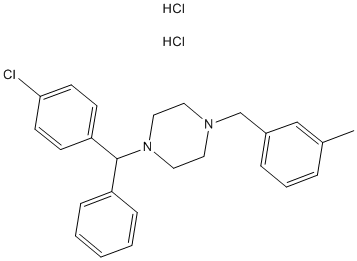All AbMole products are for research use only, cannot be used for human consumption.

Meclizine dihydrochloride is a human pregnane X receptor (hPXR) agonist and histamine H1 receptor antagonist. Meclizine dihydrochloride is stronger activator of hPXR than rat PXR. Meclizine dihydrochloride increases hPXR target gene expression in human hepatocyte primary cultures. Meclizine dihydrochloride is an antihistamine considered to be an antiemetic. Meclizine dihydrochloride possesses anticholinergic, central nervous system depressant, and local anesthetic effects. Meclizine dihydrochloride depresses labyrinth excitability and vestibular stimulation, and it may affect the medullary chemoreceptor trigger zone. Meclizine dihydrochloride is used to treat or prevent nausea, vomiting, and dizziness caused by motion sickness.
| Cell Experiment | |
|---|---|
| Cell lines | HepG2 cells |
| Preparation method | Culturing HepG2 cells in 24-well dishes with DMEM supplemented with 10% charcoal-stripped calf serum. Using calcium phosphate with 100 ng of receptor expression vectors to transfect cells , 300 ng of luciferase reporter plasmids, and 100 ng of pSV2-β-galactosidase as internal control of transfection efficiency. 12 h after transfection,adding the drugs, and incubating cells for an additional 24 h. The cell lysate is assayed for luciferase activity and normalized to β-galactosidase activity. |
| Concentrations | ~10 μM |
| Incubation time | 24 h |
| Animal Experiment | |
|---|---|
| Animal models | Mouse |
| Formulation | corn oil |
| Dosages | 100 mg/kg |
| Administration | i.p. |
| Molecular Weight | 463.87 |
| Formula | C25H27Cl2N2.2HCl |
| CAS Number | 1104-22-9 |
| Form | Solid |
| Solubility (25°C) | DMSO |
| Storage |
Powder -20°C 3 years ; 4°C 2 years In solvent -80°C 6 months ; -20°C 1 month |
[1] Bobby T. Houston, et al. Meclizine
[2] No authors listed. Antiemetic Agents
[3] No authors listed. Meclizine
| Related Histamine Receptor Products |
|---|
| Dimethindene
Dimethindene is a potent, selective histamine H1 antagonist. |
| ABT-288
ABT-288 is a competitive, potent and selective histamine H3 receptor (H3R) antagonist. |
| A-349821
A-349821 is a histamine H3 receptor antagonist characterized as a radioligand ([3H]-A-349821) for in vivo receptor occupancy assessment. |
| Betazole
Betazole (Ametazole), a pyrazole analogue of histamine, is an orally active histamine H2 receptor agonist. |
| Tiotidine
Tiotidine (ICI 125211) is a potent and selective antagonist of histamine H2-receptor (pA2=7.3-7.8 for guinea-pig right atrium). |
All AbMole products are for research use only, cannot be used for human consumption or veterinary use. We do not provide products or services to individuals. Please comply with the intended use and do not use AbMole products for any other purpose.


Products are for research use only. Not for human use. We do not sell to patients.
© Copyright 2010-2024 AbMole BioScience. All Rights Reserved.
